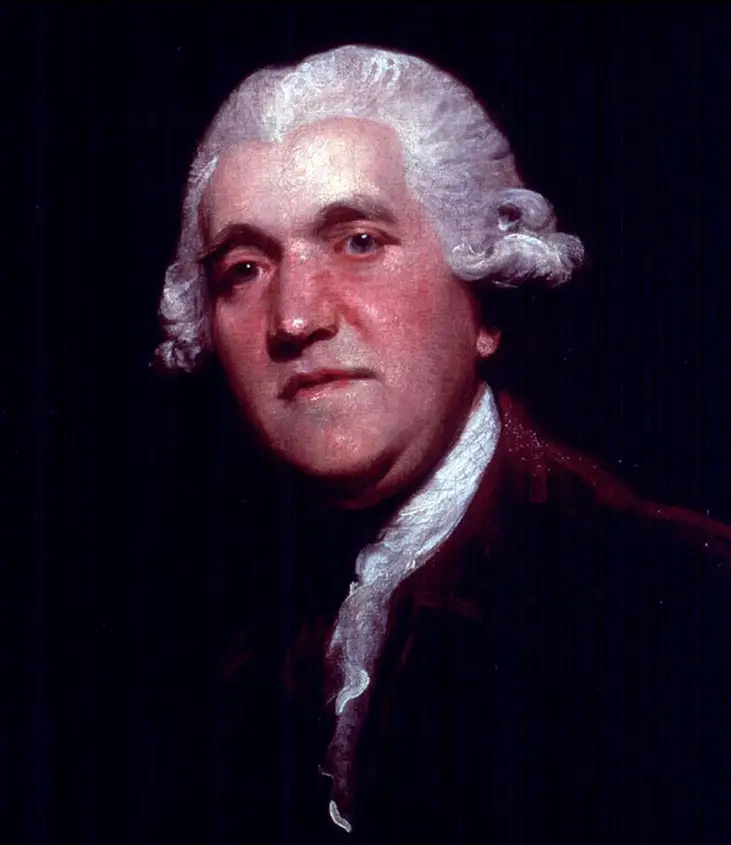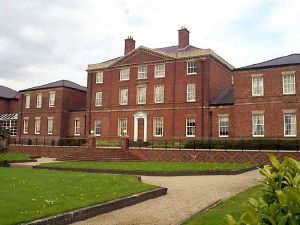Josiah Wedgewood
- This article is about the eldest Josiah Wedgwood. For his descendants with the same name see Josiah Wedgwood (disambiguation)
Josiah Wedgwood (July 12, 1730 - January 3, 1795, born Burslem, Stoke-on-Trent) was an English pottery designer and manufacturer, outstanding in his scientific approach to pottery making and known for his exhaustive researches into materials, logical deployment of labor, and sense of business organization. He apprenticed with Thomas Whieldon of Fenton Low, Staffordshire, probably the leading potter of his day.
He is credited with the industrialization of the manufacture of pottery. He perfected a cream-colored earthenware that, with the sanction of Queen Charlotte in 1765, was called Queen’s ware. He also invented Jasperware and black basalt ware in imitation of Greek red-figure vases. He created the pyrometer (a device for measuring high temperatures-invaluable for gauging oven heats for firings) which earned him commendation as a fellow of the Royal Society.
He worked toward efficient factory organization, and improving transportation of raw materials and finished wares by canals, such as the Grand Trunk Canal.
He was a member of the Darwin-Wedgwood family, his daughter Susannah, married John Darwin, their son was Charles Darwin, the father of the theory of evolution.
Biography
Early life
Born the thirteenth and youngest child of Thomas Wedgwood and Mary Wedgwood (née Stringer; d. 1766), Josiah was raised within a family of English Dissenters. He survived a childhood bout of smallpox to serve as an apprentice potter under his eldest brother Thomas Wedgwood IV. Smallpox left Josiah with a permanently weakened knee, which made him unable to work the foot pedal of a potter's wheel. As a result, he concentrated from an early age on designing pottery rather than making it.
In his early twenties, Wedgwood began working with the most renowned English pottery-maker of his day, Thomas Whieldon. There he began experimenting with a wide variety of pottery techniques, an experimentation that coincided with the burgeoning early industrial city of Manchester, which was nearby. Inspired, Wedgwood leased the Ivy Works in his home town of Burslem and set to work. Over the course of the next decade, his experimentation (and a considerable injection of capital from his marriage to a richly endowed distant cousin, Sarah Wedgwood) transformed the sleepy artisan works into the first true pottery factory.
Marriage and children
Wedgwood married Sarah Wedgwood (a third cousin). Together, they had seven children:
- Susannah Wedgwood (1765–1817) (married Robert Darwin, parents of the English naturalist Charles Darwin)
- John Wedgwood (1766–1844)
- Josiah Wedgwood II (1769–1843)
- Thomas Wedgwood (1771–1805) (no children)
- Catherine Wedgwood (1774–1823) (no children)
- Sarah Wedgwood (1776–1856) (no children)
- Mary Anne Wedgwood
Work
Wedgwood's work was of very high quality: when visiting his workshop, if he saw an offending vessel that failed to meet with his standards, he would smash it with his stick, exclaiming, "This will not do for Josiah Wedgwood!" He was also keenly interested in the scientific advances of his day and it was this interest that underpinned his adoption of its approach and methods to revolutionize the quality of his pottery. His unique glazes began to distinguish Josiah's wares from anything else on the market.
By 1763 he was receiving orders from the highest levels of the British nobility, including Queen Charlotte. Wedgwood convinced her to let him name the line of pottery she purchased "Queen's Ware," and trumpeted the royal association in his paperwork and stationery. In 1774 the Empress Catherine of Russia ordered the Green Frog Service from Wedgwood; it can still be seen in the Hermitage Museum.[1] An even earlier commission from Catherine was the Husk Service (1770), now on exhibit in Peterhof. As a burgeoning industrialist, Wedgwood was a major backer of the Trent and Mersey Canal dug between the River Trent and River Mersey, during which time he became friends with Erasmus Darwin. Later that decade, his burgeoning business caused him to move from the smaller Ivy Works to the newly-built Etruria Works, which would run for 180 years. The factory was so-named after the Etruria district of Italy, where black porcelain dating to Etruscan times was being excavated. Wedgwood found this porcelain inspiring, and his first major commercial success was its duplication with what he called "Black Basalt."
Not long after the new works opened, continuing trouble with his smallpox-afflicted knee made necessary the amputation of his right leg. In 1780, his long-time business partner Thomas Bentley died, and Wedgwood turned to Darwin for help in running the business. As a result of the close association that grew up between the Wedgwood and Darwin families, Josiah's eldest daughter would later marry Erasmus' son. One of the children of that marriage, Charles Darwin, would also marry a Wedgwood — Emma, Josiah's granddaughter. Essentially, this double-barreled inheritance of Josiah's money permitted Charles Darwin the life of leisure that allowed him the time to formulate his theory of evolution.
In the latter part of his life, Wedgwood's obsession was to duplicate the Portland Vase, a blue and white glass vase dating to the first century B.C.E. For three years he worked on the project, eventually producing what he considered a satisfactory copy in 1789. After passing on his company to his sons, Wedgwood died at home, probably of cancer of the jaw, in 1795. He was buried three days later in the parish church of Stoke-on-Trent. Seven years later a marble memorial tablet commissioned by his sons was installed there.
He belonged to the fourth generation of a family of potters whose traditional occupation continued through another five generations. Wedgwood's company is still a famous name in pottery today (as part of Waterford Wedgwood; see Waterford Crystal), and "Wedgwood China" is the commonly used term for his Jasperware, the blue (or sometimes green) china with overlaid white decoration, still common throughout the world.
He was an active member of the Lunar Society and is remembered on the Moonstones in Birmingham. He was elected to the Royal Society in 1783 for the development of a pyrometer.
He was also a prominent slavery abolitionist. He mass produced cameos depicting the seal for the Society for the Abolition of the Slave Trade and had them widely distributed, which thereby became a popular and celebrated image. The actual design of the cameo was probably done by either William Hackwood or Henry Webber who were modelers in his factory.[1]
See also
- Pottery
- Ceramic (art)
- Porcelain
Notes
- ↑ "Am I Not a Man and a Brother?" pbs.org Retrieved November 18, 2008.
ReferencesISBN links support NWE through referral fees
- Burton, William. Josiah Wedgwood and His Pottery 1922.
- Church, Sir Arthur H. Josiah Wedgwood, Master Potter 1903.
- Dolan, Brian. Wedgwood: The First Tycoon, Viking Adult, 2004. ISBN 0670033464
- Honey, William B. Wedgwood Ware, 1948.
- Mankowitz, Wolf and Reginald G. Hagger, The Concise Encyclopedia of English Pottery and Porcelain, 1957.
- Mankowitz, Wolf. Wedgwood, 1953.
External links
| Persondata | |
|---|---|
| NAME | Wedgwood, Josiah |
| ALTERNATIVE NAMES | |
| SHORT DESCRIPTION | |
| DATE OF BIRTH | 1730 |
| PLACE OF BIRTH | |
| DATE OF DEATH | 1795 |
| PLACE OF DEATH | |
Credits
New World Encyclopedia writers and editors rewrote and completed the Wikipedia article in accordance with New World Encyclopedia standards. This article abides by terms of the Creative Commons CC-by-sa 3.0 License (CC-by-sa), which may be used and disseminated with proper attribution. Credit is due under the terms of this license that can reference both the New World Encyclopedia contributors and the selfless volunteer contributors of the Wikimedia Foundation. To cite this article click here for a list of acceptable citing formats.The history of earlier contributions by wikipedians is accessible to researchers here:
The history of this article since it was imported to New World Encyclopedia:
Note: Some restrictions may apply to use of individual images which are separately licensed.


